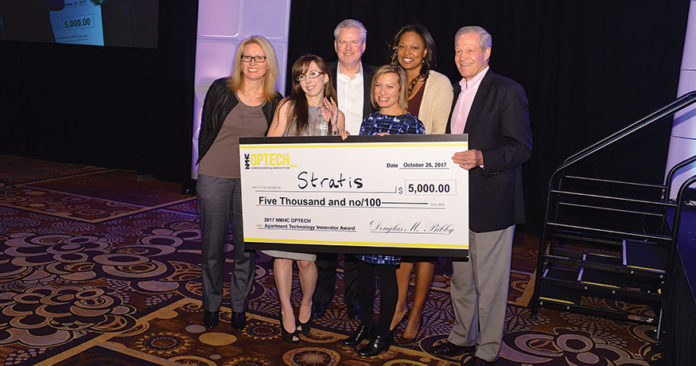
The apartment industry isn’t known for being an early adopter of new technology, but a new wave of venture capital (VC) targeting new technology in the commercial real estate (CRE) sector may change that in short order. Two years ago, there was $400 million in VC funding dedicated to commercial real estate. Today there is $2.5 billion, according to experts.
With such a big bet being placed on CRE technology, multifamily is bound to be impacted. Innovation, and potentially disruption, are likely to follow in the wake of such big investments. Advances in artificial intelligence and machine learning, virtual reality, smart home technology, technology-enabled short-term rental solutions and much more are possible.
Why is it happening?
During a town hall discussion focused on innovation during the 2017 NMHC OPTECH Conference and Exposition, apartment executives discussed at length why this growth in investment was happening and how it could potentially affect the apartment industry.
“We’ve been under the radar, but not anymore,” said Eric Potter, director of applied innovation of Waterton. “There is a concentration of capital and a lot of smart people who will be bringing new business models to our industry. If you don’t recognize them, you’re going to be left behind.”
Darren Wesemann, EVP and chief innovation officer at Berkadia, concurred, adding that “VCs are looking at us because we are 10 to 15 years behind in a lot of areas. There is clear opportunity for them as an investment thesis, but that means apartment firms are going to have a lot of noise and hype to get through to pick the solutions that will drive better resident and employee satisfaction.”
Another reason VC capital is looking at multifamily is because customer-facing companies see it as an opportunity to use our properties as incubators to gain access to our residents, said Stephanie Fuhrman, managing director of technology services at Greystar. Think Amazon Lockers.
Are we ready?
With this much investment targeting CRE specifically, forward-looking apartment leaders are anticipating a wave of new solutions for apartment operators in the next 18 to 24 months. But many fear that we may not have the systems and structures in place to capitalize on the opportunity.
In other industries, companies have a long history of incorporating research and development (R&D) in to their business models, allowing them to continually innovate and create new product lines to stave off obsolescence and disruption.
The multifamily industry hasn’t felt much of a need for R&D. But with housing often referred to as a “bundle of services” and those services now being enabled by technology, many are rethinking our traditional business model. In much the same way that Starbucks has claimed they are a technology company whose product is coffee, many are asking whether we are a technology-enabled service provider whose product is an apartment?
To help the industry exploit the anticipated incoming wave in innovation, the newly formed NMHC Organizational Innovation Committee will be rolling out its inaugural program of work in 2018. Their mission will be to highlight and support best practices for creating pathways for innovation in their corporate structure as well as in the industry writ large.
Can it integrate?
Beyond addressing corporate structure issues, the age-old challenge of getting our technologies to communicate and our data to flow seamlessly remains. With more innovation, new technology entrants and an explosion in the volume and the value of data, the need for standardization to facilitate the smooth coordination of technology and data is growing more acute.
In response, NMHC is re-activating the Multifamily Information Transactions Standards (MITS). MITS began in the early 2000s, bringing together apartment and tech leaders to reach consensus on data standards.
To help reignite discussion, NMHC is partnering with Hospitality Technology Next Generation (HTNG), a non-profit group dedicated to developing tech systems and solutions for the hotel industry. Given the synergies between the two industries, HTNG hopes to leverage its experience bringing end-users and software providers together to help both apartment operators describe the solutions they are seeking and software providers better explain the limitations they face in meeting those expectations.
While better standards could encourage more innovation, integration hurdles can have their benefits. During a related panel discussion at OPTECH, Scott Pechersky, senior vice president of technology with Alliance Residential said the fact that a new supplier has to become an “approved vendor” with existing property management systems tells him when companies are serious about serving the industry and have done their homework.
“Frankly, it helps me sell their services to third-party operators,” he said. Nevertheless, he’d said he’d like to see a future where any developer could download a toolkit and adopt an integration instead of having individual vendor APIs.
Demetri Themelis, cofounder of Knock Rentals, noted that from his standpoint as a start-up, standards are all about enabling competition, not just innovation. “No one wants the legacy systems to stop pursuing the full stack solution,” he said. “We understand why that makes sense for them. We know we have a competition overlap and we think that we all serve the operator at the end of the day and it’s in the industry’s best interest to have that competition.”
While standards may help ease some of the integration challenges, Themelis reminded attendees that the industry is a very complex sector with different investment strategies, ownership types, management structures that all want to consume data differently.














